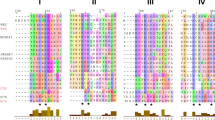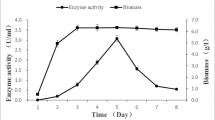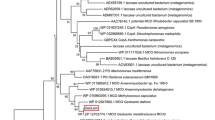Abstract
A laccase from the aquatic ascomycete Phoma sp. UHH 5-1-03 (DSM 22425) was purified upon hydrophobic interaction and size exclusion chromatography (SEC). Mass spectrometric analysis of the laccase monomer yielded a molecular mass of 75.6 kDa. The enzyme possesses an unusual alkaline isoelectric point above 8.3. The Phoma sp. laccase undergoes pH-dependent dimerisation, with the dimer (∼150 kDa, as assessed by SEC) predominating in a pH range of 5.0 to 8.0. The enzyme oxidises common laccase substrates still at pH 7.0 and 8.0 and is remarkably stable at these pH values. The laccase is active at high concentrations of various organic solvents, all together indicating a considerable biotechnological potential. One laccase gene (lac1) identified at the genomic DNA level and transcribed in laccase-producing cultures was completely sequenced. The deduced molecular mass of the hypothetical protein and the predicted isoelectric point of 8.1 well agree with experimentally determined data. Tryptic peptides of electrophoretically separated laccase bands were analysed by nano-liquid chromatography–tandem mass spectrometry. By using the nucleotide sequence of lac1 as a template, eight different peptides were identified and yielded an overall sequence coverage of about 18%, thus confirming the link between lac1 and the expressed laccase protein.




Similar content being viewed by others
References
Altschul SF, Madden TL, Schaffer AA, Zhang J, Zhang Z, Miller W, Lipman DJ (1997) Gapped blast and psi-blast: a new generation of protein database search programs. Nucleic Acids Res 25:3389–3402
Baldrian P (2006) Fungal laccases—occurence and properties. FEMS Microbiol Rev 30:215–242
Bannai H, Tamada Y, Maruyama O, Nakai K, Miyano S (2002) Extensive feature detection of N-terminal protein sorting signals. Bioinformatics 18:298–305
Beloqui A, Pita M, Polaina J, Martinez-Arias A, Golyshina OV, Zumarraga M, Yakimov MM, Garcia-Arellano H, Alcalde M, Fernandez VM, Elborough K, Andreu JM, Ballesteros A, Plou FJ, Timmis KN, Ferrer M, Golyshin PN (2006) Novel polyphenol oxidase mined from a metagenome expression library of bovine rumen: biochemical properties, structural analysis, and phylogenetic relationships. J Biol Chem 281:22933–22942
Bendtsen JD, Nielsen H, von Heijne G, Brunak S (2004) Improved prediction of signal peptides: SignalP 3.0. J Mol Biol 340:783–795
Benndorf D, Balcke GU, Harms H, von Bergen M (2007) Functional metaproteome analysis of protein extracts from contaminated soil and groundwater. ISME J 1:224–234
Berka RM, Schneider P, Golightly EJ, Brown SH, Madden M, Brown KM, Halkier T, Mondorf K, Xu F (1997) Characterization of the gene encoding an extracellular laccase of Myceliophthora thermophila and analysis of the recombinant enzyme expressed in Aspergillus oryzae. Appl Environ Microbiol 63:3151–3157
Esser K, Minuth W (1970) The phenoloxidases of the ascomycete Podospora anserina. Communication IV. Genetic regulation of the formation of laccase. Genetics 64:441–458
Ettrich R, Kopecky V, Hofbauerova K, Baumruk V, Novak P, Pompach P, Man P, Plihal O, Kuty M, Kulik N, Sklenar J, Ryslava H, Kren V, Bezouska K (2007) Structure of the dimeric N-glycosylated form of fungal beta-N-acetylhexosaminidase revealed by computer modeling, vibrational spectroscopy, and biochemical studies. BMC Struct Biol 7:32–46
Faraco V, Ercole C, Festa G, Giardina P, Piscitelli A, Sannia G (2008) Heterologous expression of heterodimeric laccase from Pleurotus ostreatus in Kluyveromyces lactis. Appl Microbiol Biotechnol 77:1329–1335
Fernandez-Larrea J, Stahl U (1996) Isolation and characterization of a laccase gene from Podospora anserina. Mol Gen Genet 252:539–551
Gasteiger E, Hoogland C, Gattiker A, Duvaud S, Wilkins MR, Appel RD, Bairoch A (2005) The proteomics protocols handbook. Humana, Totowa
Gianfreda L, Xu F, Bollag JM (1999) Laccases: a useful group of oxidoreductive enzymes. Bioremediat J 3:1–26
Giardina P, Palmieri G, Scaloni A, Fontanella B, Faraco V, Cennamo G, Sannia G (1999) Protein and gene structure of a blue laccase from Pleurotus ostreatus. Biochem J 341:655–663
Hall TA (1999) Bioedit: a user-friendly biological sequence alignment editor and analysis program for windows 95/98NT. Nucleic Acids Symp Ser 41:95–98
Hoegger PJ, Kilaru S, James TY, Thacker JR, Kües U (2006) Phylogenetic comparison and classification of laccase and related multicopper oxidase protein sequences. FEBS J 273:2308–2326
Iyer G, Chattoo BB (2003) Purification and characterization of laccase from the rice blast fungus, Magnaporthe grisea. FEMS Microbiol Lett 227:121–126
Johannes C, Majcherczyk A (2000) Laccase activity tests and laccase inhibitors. J Biotechnol 78:193–199
Junghanns C, Krauss G, Schlosser D (2008a) Potential of aquatic fungi derived from diverse freshwater environments to decolourise synthetic azo and anthraquinone dyes. Bioresource Technol 99:1225–1235
Junghanns C, Parra R, Keshavarz T, Schlosser D (2008b) Towards higher laccase activities produced by aquatic ascomycetous fungi through combination of elicitors and an alternative substrate. Eng Life Sci 8:277–285
Kellner H, Jehmlich N, Benndorf D, Hoffmann R, Rühl M, Hoegger PJ, Majcherczyk A, Kües U, von Bergen M, Buscot F (2007a) Detection, quantification and identification of fungal extracellular laccases using polyclonal antibody and mass spectrometry. Enzyme Microb Tech 41:694–701
Kellner H, Luis P, Buscot F (2007b) Diversity of laccase-like multicopper oxidase genes in Morchellaceae: identification of genes potentially involved in extracellular activities related to plant litter decay. FEMS Microbiol Ecol 61:153–163
Kiiskinen LL, Saloheimo M (2004) Molecular cloning and expression in Saccharomyces cerevisiae of laccase gene from the ascomycete Melanocarpus albomyces. Appl Environ Microbiol 70:137–144
Kiiskinen LL, Viikari L, Kruus K (2002) Purification and characterisation of a novel laccase from the ascomycete Melanocarpus albomyces. Appl Microbiol Biotechnol 59:198–204
Liers C, Ullrich R, Pecyna M, Schlosser D, Hofrichter M (2007) Production, purification and partial enzymatic and molecular characterization of a laccase from the wood-rotting ascomycete Xylaria polymorpha. Enzyme Microb Tech 41:785–793
Lin C-T, Lin M-T, Chen Y-T, Shaw J-F (1995) Subunit interaction enhances enzyme activity and stability of sweet potato cytosolic Cu/Zn-superoxide dismutase purified by a His-tagged recombinant protein method. Plant Mol Biol 28:303–311
Litvintseva AP, Henson JM (2002) Cloning, characterization, and transcription of three laccase genes from Gaeumannomyces graminis var. tritici, the take-all fungus. Appl Environ Microbiol 68:1305–1311
Martin C, Pecyna M, Kellner H, Jehmlich N, Junghanns C, Benndorf D, von Bergen M, Schlosser D (2007) Purification and biochemical characterization of a laccase from the aquatic fungus Myrioconium sp. UHH 1–13-18–4 and molecular analysis of the laccase-encoding gene. Appl Microbiol Biotechnol 77:613–624
Neuhoff V, Stamm R, Eibl H (1985) Clear background and highly sensitive protein staining with coomassie blue dyes in polyacrylamide gels: A systematic analysis. Electrophoresis 6:427–448
Perry CR, Matcham SE, Wood DA, Thurston CF (1993) The structure of laccase protein and its synthesis by the commercial mushroom Agaricus bisporus. J Gen Microbiol 139:171–178
Reid ID, Paice MG (1994) Biological bleaching of kraft pulps by white-rot fungi and their enzymes. FEMS Microbiol Rev 13:369–375
Reinhammar B (1970) Purification and properties of laccase and stellacyanin from Rhus vernicifera. BBA-Bioenergetics 205:35–47
Riva S (2006) Laccases: blue enzymes for green chemistry. Trends Biotechnol 24:219–226
Robles A, Lucas R, Martinez-Canamero M, Ben Omar N, Perez R, Galvez A (2002) Characterisation of laccase activity produced by the hyphomycete Chalara (syn. Thielaviopsis) paradoxa CH32. Enzyme Microb Tech 31:516–522
Rogalski J, Dawidowicz A, Jozwik E, Leonowicz A (1999) Immobilization of laccase from Cerrena unicolor on controlled porosity glass. J Mol Catal B: Enzym 6:29–39
Sambrook J, Fritsch EF, Maniatis T (1989) Molecular cloning: a laboratory manual, 2nd edn. Cold Spring Harbor Laboratory, New York
Shapiro MB, Senapathy P (1987) RNA splice junctions of different classes of eukaryotes: sequence statistics and functional implications in gene expression. Nucleic Acids Res 15:7155–7174
Shearer CA, Descals E, Kohlmeyer B, Kohlmeyer J, Marvanova L, Padgett D, Porter D, Raja HA, Schmit JP, Thorton HA, Voglymayr H (2007) Fungal biodiversity in aquatic habitats. Biodivers Conserv 16:49–67
Shevchenko A, Jensen ON, Podtelejnikov AV, Sagliocco F, Wilm M, Vorm O, Mortensen P, Shevchenko A, Boucherie H, Mann M (1996) Linking genome and proteome by mass spectrometry: large-scale identification of yeast proteins from two dimensional gels. Proc Natl Acad Sci U S A 93:14440–14445
Trovaslet M, Enaud E, Guiavarc'h Y, Corbisier A-M, Vanhulle S (2007) Potential of a Pycnoporus sanguineus laccase in bioremediation of wastewater and kinetic activation in the presence of an anthraquinonic acid dye. Enzyme Microb Tech 41:368–376
Wahleithner JA, Xu F, Brown K, Brown S, Golightly E, Halkier T, Kauppinen S, Pederson A, Schneider P (1996) The identification and characterization of four laccases from the plant pathogenic fungus Rhizoctonia solani. Curr Genet 29:395–403
Wesenberg D, Kyriakides I, Agathos SN (2003) White-rot fungi and their enzymes for the treatment of industrial dye effluents. Biotechnol Adv 22:161–187
Xu F, Shin W, Brown SH, Wahleithner JA, Sundaram UM, Solomon EI (1996) A study of a series of recombinant fungal laccases and bilirubin oxidase that exhibit significant differences in redox potential, substrate specificity, and stability. BBA-Protein Struct M 1292:303–311
Acknowledgements
We gratefully acknowledge the funding of this study by the European Commission within the frame of the Integrated Project SOPHIED (NMP2-CT-2004-505899) of the 6th framework programme. Many thanks to A. Bazes, E. Enaud, M. Trovaslet, S. Vanhulle (all Université Catholique de Louvain, Louvain-la-Neuve, Belgium) and H. Kellner (University Gembloux, Belgium) for fruitful discussions. Furthermore, we want to thank R. Bötz (UFZ) for excellent technical assistance.
Author information
Authors and Affiliations
Corresponding author
Rights and permissions
About this article
Cite this article
Junghanns, C., Pecyna, M.J., Böhm, D. et al. Biochemical and molecular genetic characterisation of a novel laccase produced by the aquatic ascomycete Phoma sp. UHH 5-1-03. Appl Microbiol Biotechnol 84, 1095–1105 (2009). https://doi.org/10.1007/s00253-009-2028-2
Received:
Revised:
Accepted:
Published:
Issue Date:
DOI: https://doi.org/10.1007/s00253-009-2028-2




